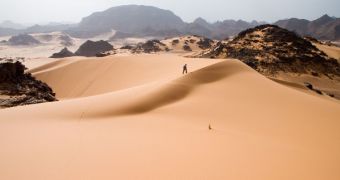Global warming is more familiar to people for its potential effects in melting the polar ice caps, and in endangering low-lying countries and coast lines. However, one of its most devastating aspects is the fact that it can effortlessly promote desertification in areas that are already arid, and therefore prone to such a calamity. According to a new survey, which was conducted using the Life Cycle Assessment (LCA), 38 percent of the world's surface meets this criteria, which means that people living here are in danger of eventually becoming trapped in an ever-expanding desert.
The LCA is a very important methodology, which is used to analyze the way human activities impact the environment. For the very first time ever, the new research has also included indicators for desertification when applying the tool to the current global situation. The objective of the study was to assess the amount of global soil degradation.
“Despite improvements in the LCA, it has a methodological weakness, which is a lack of environmental impact categories to measure the effect of human activities such as cultivation or grazing on the soil,” Institute of Agro Food Research and Technology (IRTA) researcher Montserrat Nunez tells SINC, PhysOrg reports.
Nunez is also the lead author of a new paper detailing the results of the LCA analysis, which is published in the latest issue of the International Journal of Life Cycle Assessment. In the study, the world was divided into 15 areas, based on the degree of aridity each of them exhibited. According to the LCA tool, about eight of these areas are in danger of becoming deserts soon, and this amounts to about 38 percent of the surface of the entire land mass.
“The greatest risk of desertification (7.6 out of 10 on a scale produced using various desertification indicators) is in the subtropical desert regions – North Africa, the countries of the Middle East, Australia, South West China and the western edge of South America,” the expert adds. Other regions at risk, included in the eight eco-regions, are coastal areas, the prairies, the Mediterranean region, the savanna, the temperate steppes, the temperate deserts, tropical and subtropical steppes, and the tropical and subtropical deserts.
“Unsustainable land use may lead to soil becoming degraded. If this happens in arid, semi-arid and dry sub-humid regions, such as Spain, this degradation is known as desertification, and the effects can be irreversible, because they lead to areas becoming totally unproductive,” the expert adds.

 14 DAY TRIAL //
14 DAY TRIAL //